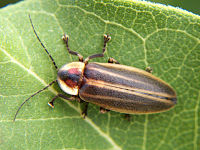
Photo from wikipedia
Simple Summary Nocturnal fireflies are facing various challenges to their survival (e.g., artificial light pollution and extreme climate change). However, there are still no effective diagnostic tools to distinguish firefly… Click to show full abstract
Simple Summary Nocturnal fireflies are facing various challenges to their survival (e.g., artificial light pollution and extreme climate change). However, there are still no effective diagnostic tools to distinguish firefly species and monitor how their population size and nocturnal behavior change in the wild. Here, we demonstrated that flash interval (FI), a timing character of firefly flash signaling, can be a reliable species-specific luminescent marker for identifying three species (Abscondita cerata, Luciola kagiana, and Luciola curtithorax) in a wild sympatric population and evaluating their nightly behaviors in video-imagery analysis, as well as a traditional field specimen collection. Our studies provide key information and valuable references for future studies of (1) the behaviors of sympatric fireflies in the wild and (2) the development of automatic and rapid digital diagnostic tools for identifying firefly species and quantifying population size, especially for firefly conservation. Abstract It is highly challenging to evaluate the species’ content and behavior changes in wild fireflies, especially for a sympatric population. Here, the flash interval (FI) and flash duration (FD) of flying males from three sympatric species (Abscondita cerata, Luciola kagiana, and Luciola curtithorax) were investigated for their potentials in assessing species composition and nocturnal behaviors during the A. cerata mating season. Both FI and FD were quantified from the continuous flashes of adult fireflies (lasting 5–30 s) via spatiotemporal analyses of video recorded along the Genliao hiking trail in Taipei, Taiwan. Compared to FD patterns and flash colors, FI patterns exhibited the highest species specificity, making them a suitable reference for differentiating firefly species. Through the case study of a massive occurrence of A. cerata (21 April 2018), the species contents (~85% of the flying population) and active periods of a sympatric population comprising A. cerata and L. kagiana were successfully evaluated by FI pattern matching, as well as field specimen collections. Our study suggests that FI patterns may be a reliable species-specific luminous marker for monitoring the behavioral changes in a sympatric firefly population in the field, and has implication values for firefly conservation.
Journal Title: Biology
Year Published: 2022
Link to full text (if available)
Share on Social Media: Sign Up to like & get
recommendations!